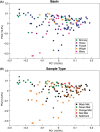Patterns of bacterial biodiversity in the glacial meltwater streams of the McMurdo Dry Valleys, Antarctica
- PMID: 27495241
- PMCID: PMC5975864
- DOI: 10.1093/femsec/fiw148
Patterns of bacterial biodiversity in the glacial meltwater streams of the McMurdo Dry Valleys, Antarctica
Abstract
Microbial consortia dominate glacial meltwater streams from polar regions, including the McMurdo Dry Valleys (MDV), where they thrive under physiologically stressful conditions. In this study, we examined microbial mat types and sediments found in 12 hydrologically diverse streams to describe the community diversity and composition within and across sites. Sequencing of the 16S rRNA gene from 129 samples revealed ∼24 000 operational taxonomic units (<97% DNA similarity), making streams the most biodiverse habitat in the MDV. Principal coordinate analyses revealed significant but weak clustering by mat type across all streams (ANOSIM R-statistic = 0.28) but stronger clustering within streams (ANOSIM R-statistic from 0.28 to 0.94). Significant relationships (P < 0.05) were found between bacterial diversity and mat ash-free dry mass, suggesting that diversity is related to the hydrologic regimes of the various streams, which are predictive of mat biomass. However, correlations between stream chemistry and community members were weak, possibly reflecting the importance of internal processes and hydrologic conditions. Collectively, these results suggest that localized conditions dictate bacterial community composition of the same mat types and sediments from different streams, and while MDV streams are hotspots of biodiversity in an otherwise depauperate landscape, controls on community structure are complex and site specific.
Keywords: 16S rRNA gene; community structure; cyanobacteria; diversity; microbial mats; polar region.
© FEMS 2016. All rights reserved. For permissions, please e-mail: journals.permissions@oup.com.
Figures







References
-
- Alger A, McKnight D, Spaulding S, et al. Occasional Paper. University of Colorado; 1997. Ecological processes in a cold desert ecosystem: the abundance and species distribution of algal mats in glacial meltwater streams in Taylor Valley, Antarctica.
-
- Allen M, Goh F, Burns B, et al. Bacterial, archaeal and eukaryotic diversity of smooth and pustular microbial mat communities in the hypersaline lagoon of Shark Bay. Geobiology. 2009;7:82–96. - PubMed
MeSH terms
Substances
Grants and funding
LinkOut - more resources
Full Text Sources
Other Literature Sources
Research Materials
Miscellaneous

